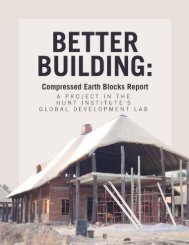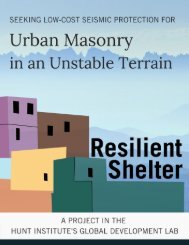Assessment of Rwanda Refugee Camps in the Context of the Villagization Process
Undergraduate researcher for the Hunt Institute for Engineering and Humanity and Engaged Learning Fellow Sienna Dugan, researched secondary sources and primary research through site visits, participatory observation, and interviews with key informants to compile this report which is structured like a case study with additional literature review. All photography is original to the student from her in-field research.
Undergraduate researcher for the Hunt Institute for Engineering and Humanity and Engaged Learning Fellow Sienna Dugan, researched secondary sources and primary research through site visits, participatory observation, and interviews with key informants to compile this report which is structured like a case study with additional literature review. All photography is original to the student from her in-field research.
You also want an ePaper? Increase the reach of your titles
YUMPU automatically turns print PDFs into web optimized ePapers that Google loves.
1.1 UNHCR and Human Rights Documents
In 1950, the office of the United Nations High Commissioner for Refugees (UNHCR) was
formed in response to the high level of Europeans whom had fled or lost their home as a result of
the Second World War. Today, over 68 years later, UNHCR is working to provide protection to
what is referred to as the “Global Refugee Crisis”. With 70.8 million people forced from their
homes, this is the highest level of displacement on record. The latest data published by the United
Nations High Commissioner for Refugees, separates these persons into four categories: Internally
Displaced Persons (IDP’s), Refugees, Stateless Persons, and Asylum Seekers.
In 1951, UNHCR ratified the 1951 Convention Relating to the Status of Refugees which
is rooted in Article 14 of the Universal Declaration of Human Rights (UDHR) stating that
“everyone has the right to seek and to enjoy in other countries asylum from persecution”.2
Subjected to an amendment in 1967, which removed the geographic and temporal limits of the
convention, this document serves as the most comprehensive codification for the rights of refugees
accepted on the international level. Rooted in fundamental principles of non-discrimination, nonpenalization,
and the treatment of refugees in concordance with fundamental human rights and
freedoms without discrimination as to sex, age, disability, sexuality, or other prohibited grounds
for discrimination, this document provides a framework to assure an adequate standard of living.
With ongoing increasing levels of development through transportation and communication, the
world in experiencing higher rates of the movement of people, goods, and information across
borders. Although these include voluntary movements, such developments have also resulted in
the involuntary movement of persons in response to increased violence as a repercussion of the
2 “Universal Declaration of Human Rights.” United Nations, United Nations, 1948, www.un.org/en/universal-declaration-humanrights/index.html.














